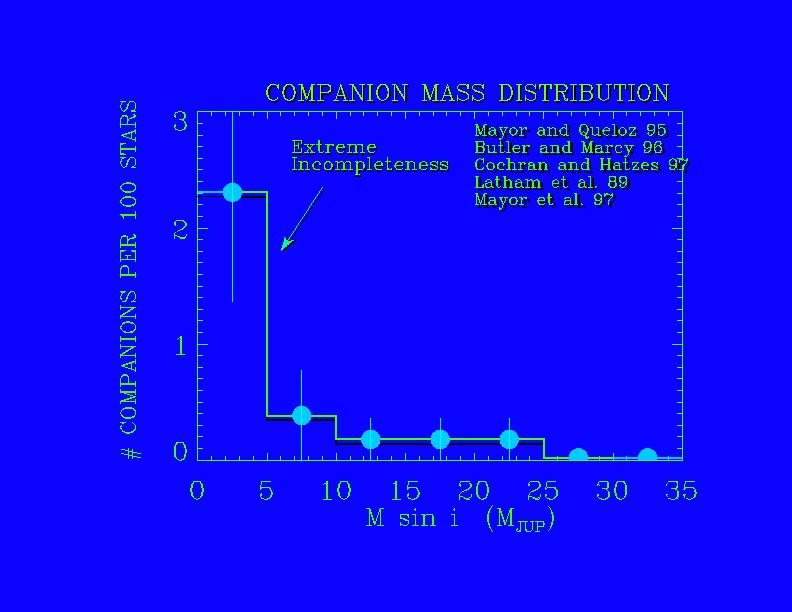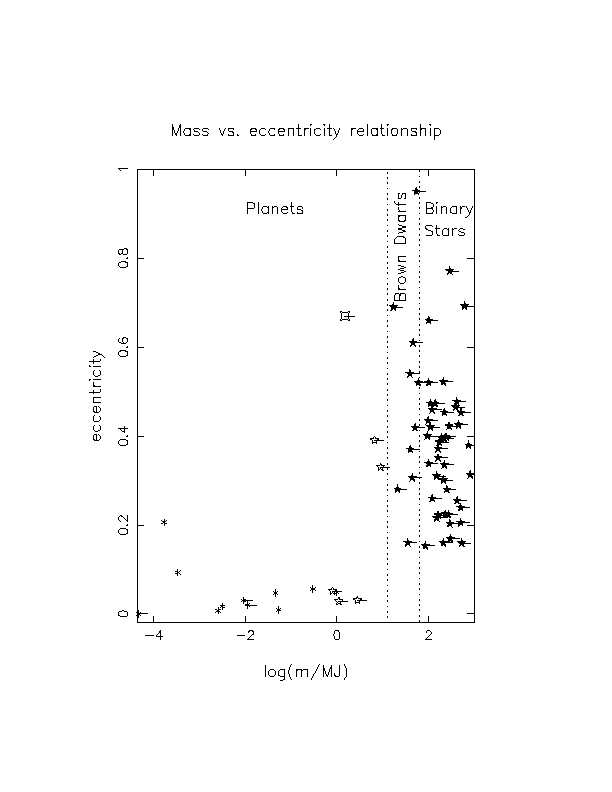 table of
contents of "Planetary systems and their changing theories"
table of
contents of "Planetary systems and their changing theories"
 next topic
next topic
4. Other worlds predicted and
interpreted by theory: Orbital Eccentricity
Besides `hot Jupiters', the other
unexpected observation that cries for explanation is the presence of
eccentric super-Jovian planets (or `superplanets').
Why did we expect circular orbits?
It was usually thought very difficult to form planets on
eccentric orbits. The arguments ranged from weak or incorrect
(red items), to somewhat uncertain
(blue item), to convincing ones
(green items).
 planetesimals are born on circular orbits
planetesimals are born on circular orbits
 all bodies are circularized
efficiently by gas drag
all bodies are circularized
efficiently by gas drag
 impactors (planetesimals)
are much smaller than target planets
impactors (planetesimals)
are much smaller than target planets
 protoplanets are subject
to resonant eccentricity damping
involving Lindblad resonances
protoplanets are subject
to resonant eccentricity damping
involving Lindblad resonances
 even when a disk
gap opens e-damping (corotational)
resonances win
even when a disk
gap opens e-damping (corotational)
resonances win
 a planet placed
somehow on a high-e orbit is circularized quickly
a planet placed
somehow on a high-e orbit is circularized quickly
A successful theory should explain both the statistics
of substellar companions, and the eccentricity-mass relation.
The statistics of substellar companions
It seems that superplanets (masses of order 10 Jupiter masses)
are a high-mass tail of the planetary distribution, rather than
a low-mass tail of brown dwarfs (cf. a
plot from San Fancisco Univ. planet search program home page):

This plot changes as we get to
know more about brown dwarf candidates (many of them
recently turned out to be stars on orbits seen almost pole-on!), and about
planetary candidates (their number, in contrast, is growing very rapidly,
cf. the Encyclopaedia of Jean
Schneider). The separate identity/origin of the companions with
minimum masses below 10 time Jupiter mass is becoming almost self-evident.
The eccentricity-mass relation in stellar, brown-dwarf, and
planetary systems
The following diagram excludes all those systems whose orbital
periods are short enough that the estimated time for tidal circularization
by star-planet (or primary-secondary) tides is less than the age of the
system. Such systems are now on circular orbits, but the original eccentricity
is unknown, and therefore they say little about the
origin of eccentricity or its relation to mass.
(Figure courtesy of Michael Hellden.)

Eccentricity generation mechanisms
The theories can be divided into groups
corresponding to different formation mechanisms:
(A)
Direct molecular cloud fragmentation
(B)
Protostellar disk fragmentation theories
(C)
Companion star-planet interaction (in double star like 16 Cyg)
(D)
Classical giant planet formation w/planet-planet interaction
Resonant disk-planet interaction
The following papers contain more details
about theories (A)-(E):
-
A compressed postscript file with a 1997 Tenerife conference paper
"On the formation of eccentric superplanets"
by P. Artymowicz is available from the
Stockholm Obs. reprints
page.
-
The Blois conference volume (1998, in print) contains the paper
"Planetary systems and their changing theories" (Artymowicz, Lubow & Kley)
posted at the
Stockholm Obs. preprints
page.
 table of
contents
table of
contents
 next topic:
Can large planets and brown dwarfs form in disks?
next topic:
Can large planets and brown dwarfs form in disks?
![]() planetesimals are born on circular orbits
planetesimals are born on circular orbits
![]() all bodies are circularized
efficiently by gas drag
all bodies are circularized
efficiently by gas drag
![]() impactors (planetesimals)
are much smaller than target planets
impactors (planetesimals)
are much smaller than target planets
![]() protoplanets are subject
to resonant eccentricity damping
involving Lindblad resonances
protoplanets are subject
to resonant eccentricity damping
involving Lindblad resonances
![]() even when a disk
gap opens e-damping (corotational)
resonances win
even when a disk
gap opens e-damping (corotational)
resonances win
![]() a planet placed
somehow on a high-e orbit is circularized quickly
a planet placed
somehow on a high-e orbit is circularized quickly

